Mastery of heavenly shooting: what's new in Phantom 4 from DJI
Say quadrocopter - DJI pops up in my head automatically. We say DJI - footage of stunning video from a bird's-eye view is floating before your eyes. The mountains. Rivers. Sunsets More recently, DJI has updated its consumer appliance line, introducing the fourth generation of the Phantoms.
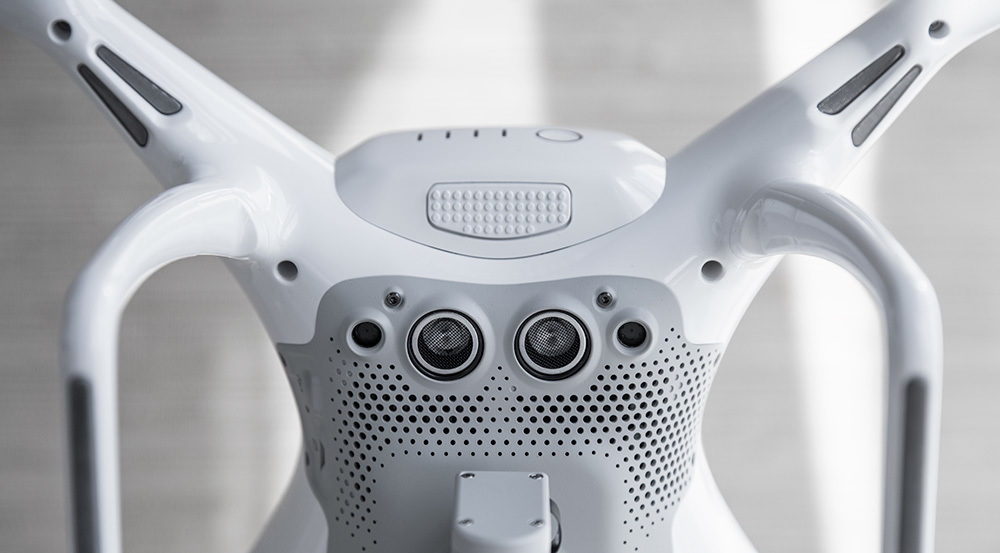
Phantom 4. Without any there Advanced, Pro and other consoles. What has changed, what has remained the same, how critical the changes are and how much will have to pay for all this magnificence - read here today.
One step is revolutionary, the second is evolutionary. So does Intel, so does Apple, so does DJI. This strategy even has a completely official name, " Tick-Tac ". Continuity in design and common features seem to be the same, if you don’t look at quadcopters every day, to say what has changed ... is difficult. Inside, everything is completely different. Literally every aspect of the drone has been redesigned. It is time to open the box and find out what's new there.
')
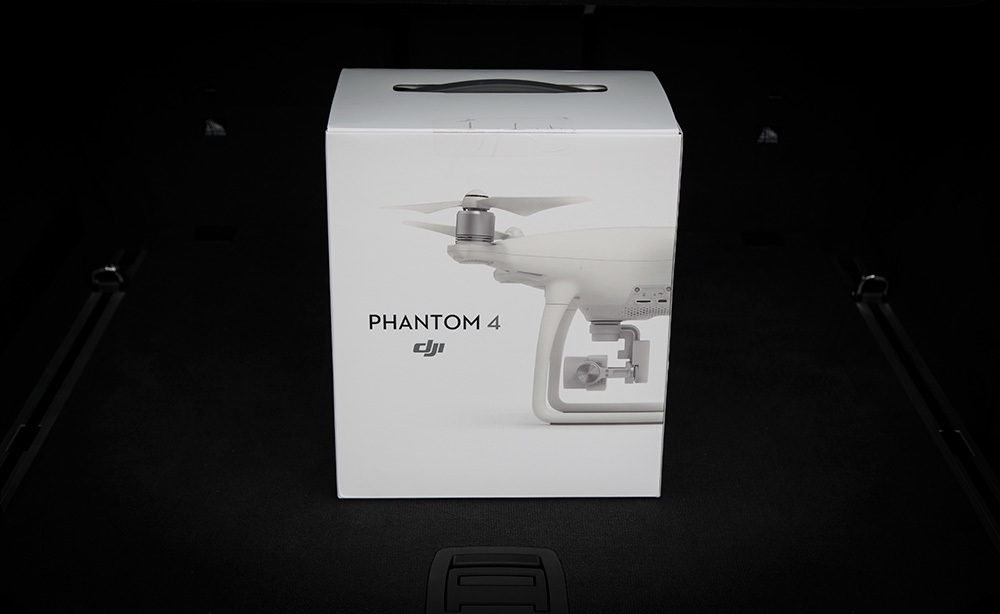


The device comes in a case with a handle, which can be used to transport the device - inside it contains all the parts (the drone itself, the remote, the blades, the tablet, charging and other trifles), and there is also a locking mechanism.
Shooting from the air - perhaps the key function of this class of devices. In the end, you do not just fly it so take it? Here it is. And the quality of the shooting in this case is influenced by two things: the camera module itself (matrix, optics) and how it is stabilized. And here and there, the new Phantom 4 has arguments.

In previous models, the camera attachment mechanism was visible: the rubberized vibration protection attached the stabilizer subframe to the frame with motors, the stabilizer itself was quite large and heavy. The four in this plan looks much simpler. The gyrostabilizer and vibroprotection are integrated into the design of the drone: the motors are more precise, the unsprung masses are lower, and the stabilization system now no longer uses only its own separate set of sensors, eliminating the effects of the movements, but receives data from the drone itself, and can calculate and compensate the movement before how it will begin.


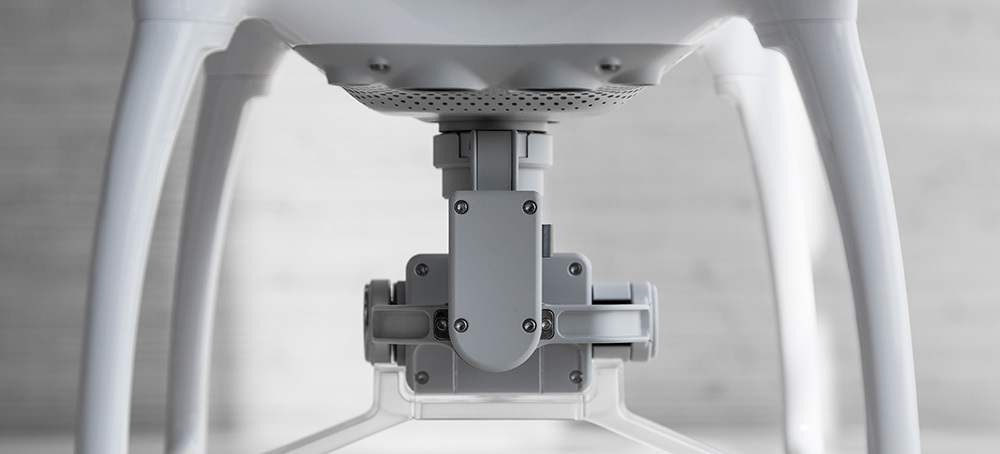
The camera module has also been updated: perhaps, today it is one of the best “flying” cameras in the user segment. The matrix size is 1 / 2.3 "(like the standard" soap cases ", but still much larger than that of smartphones). Optics with a fixed focal length and viewing angle of 94 degrees are designed specifically for this matrix and taking into account the use of" in the sky ". The relative aperture of the aperture is f / 2.8, the focus is fixed at infinity. The zone of sharpness is approximately from 50-70 centimeters from the lens.
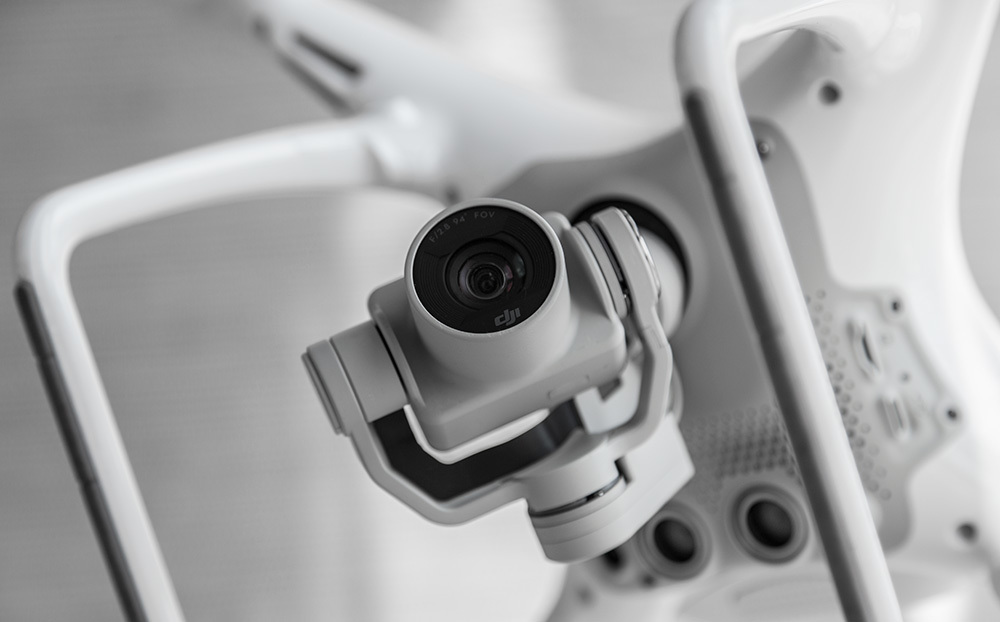
The main "limiter" with this camera module is the processor that will process the video stream. Its bandwidth is not bad - about 60 megabits per second, but this is far from a record.
At 4k2k and 2.7k (2716x1524) resolutions, the maximum available frame rate is 30. (2.7k is compressed from 4k2k, its main purpose is to save space, therefore the frame rate is the same as for higher resolution). A FullHD frame carries four times less information, so a four times higher frame rate is available for the FullHD format — up to 120FPS. Use it to increase the smoothness of the picture or slow down time - here, as you please.
Surprisingly, 720p is limited to 60FPS, apparently, it is also obtained by compressing FullHD, and the signal processor resources simply are not enough for 120FPS and video stream compression at the same time.
The developers have taken care that you can not only shoot, but also edit the video. For this camera added support for professional formats D-Log and Cine-D. Watching them “as is” is not much fun, but while processing and color correction in such a video there is much more useful information, you can achieve expressive shots in the shadows, and stunning bright sunsets, without changing the settings or interrupting the shooting.
This is what D-Log is capable of.
Of course, all 12 megapixels of the camera module are available in photographing mode. As a result, you can choose both classic .jpeg and / or Adobe RAW format (DNG).
From the box, the drone is able to shoot time lapse, carry out the usual serial shooting (up to 7 frames), as well as remove blanks for HDR with an exprovilka - from 3 to 5 frames in 0.7 EV steps.
Sample photos (with a small post-processing of the RAW file; clickable):

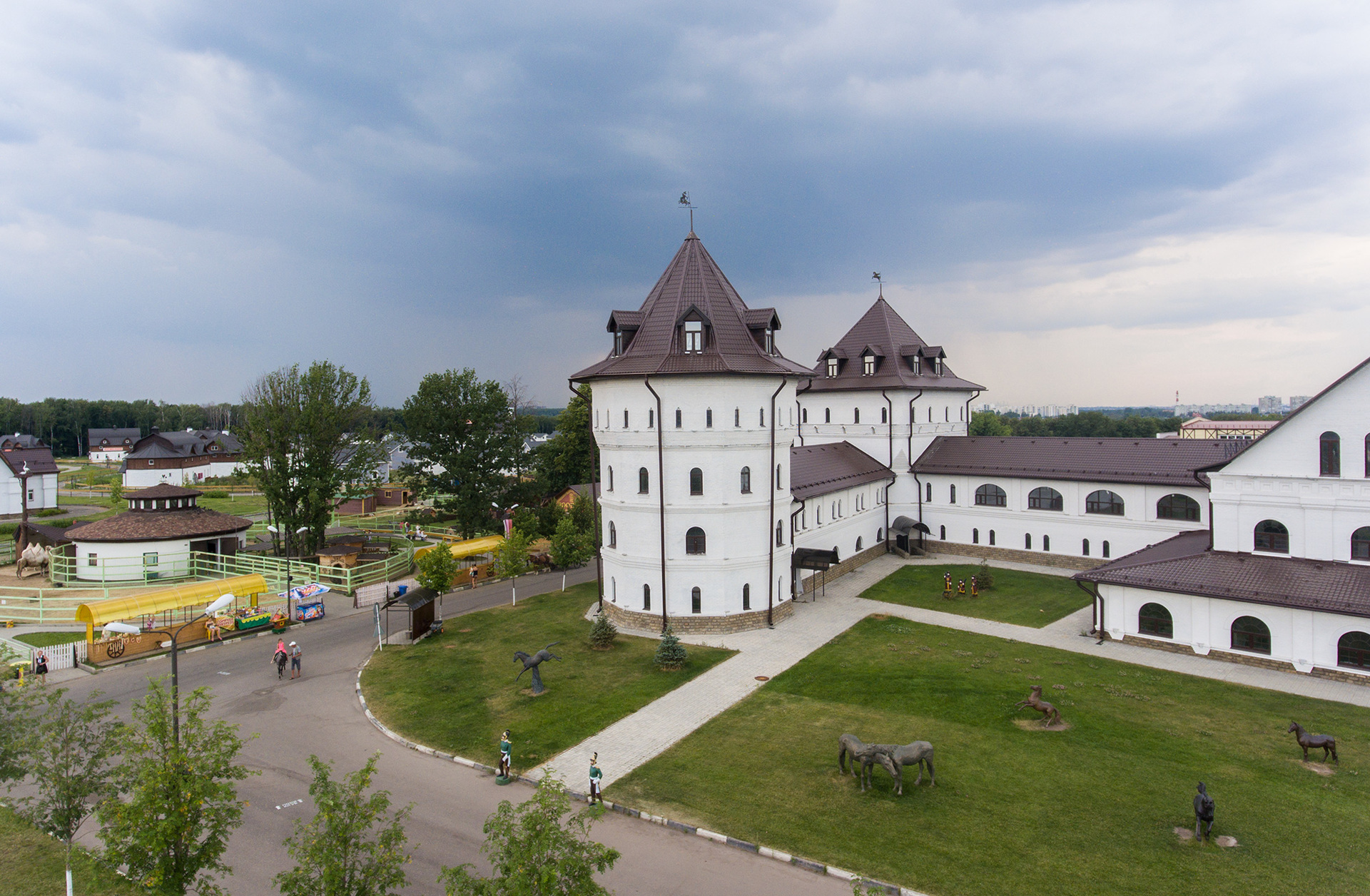




The camera is a camera, but it still needs to be delivered to heaven. In the most primitive version, the quadcopter frame is assembled from sticks and ... electrical tape. And nothing flies. But Phantom 4 is quite far from the word "primitive." His frame is a small work of art. Lightweight Durable in torsion. Minimally affecting the flow of exhaust air. Yes, and streamlined.
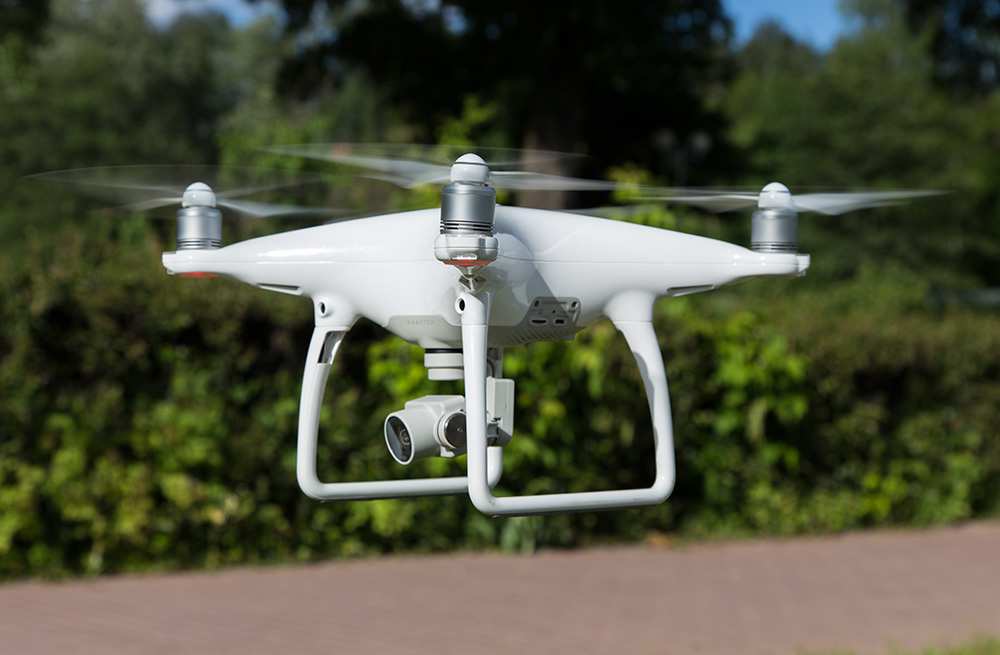
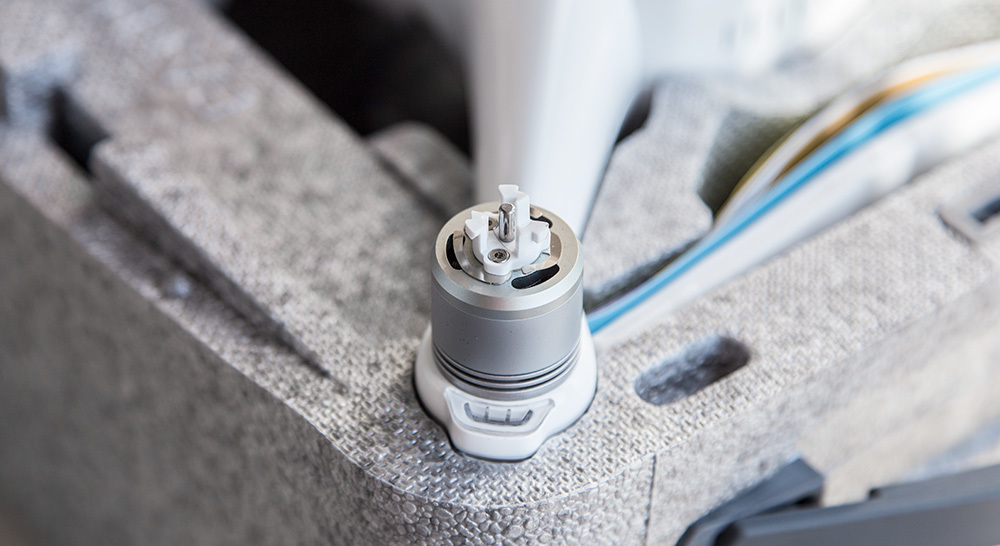
With a slight movement of the hand ... the blades are fixed on the little motors, and the Phantom 4 will only have to turn on - from the state “in the box” to “ready to fly” with proper skill it takes no more than a minute.
What does this give? The drone flies faster, higher, further (especially if you consider that the main problem for "further" are batteries and communication - here every milliamp saved by the resultant sound aerodynamics is a plus). Its less shakes the wind. The attachment point of the gimbal and the camera became closer to the center of mass, which means that the drone itself is easier to balance (and less energy is spent on it), and this also means that the camera suspension needs to spend less energy and time to deflect and correct rolls.
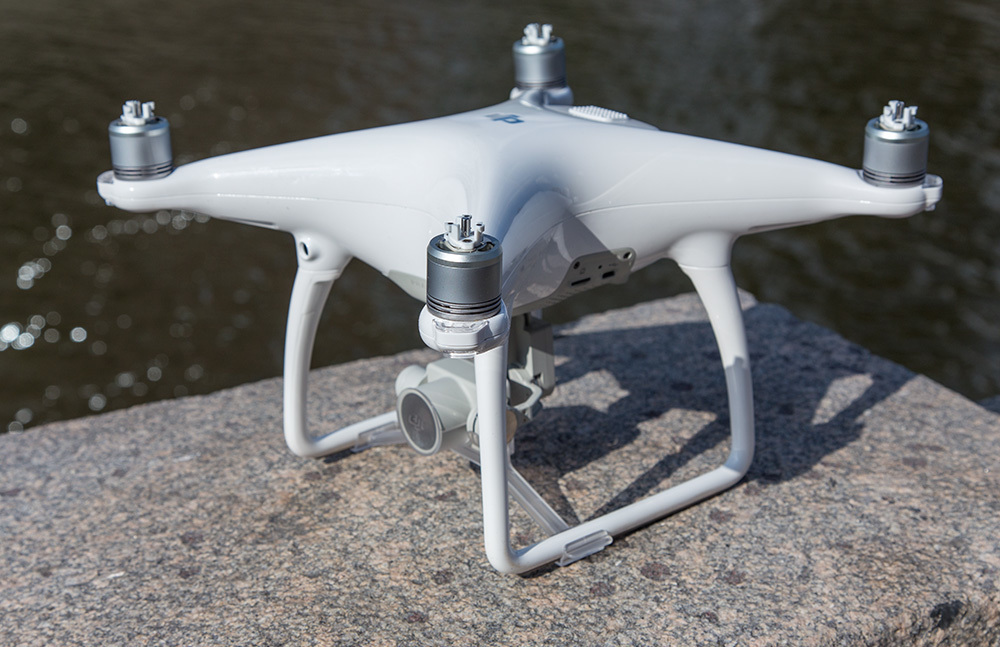
In general, there are improvements in aerodynamics, and there are continuous advantages from them. All of them in one way or another reduce energy consumption, simplify management and make video shooting more stable.
But it was not enough for engineers just to achieve amazing results with just one body. They added to this splendor 2 additional cameras and 2 ultrasonic sonars used to stabilize the flight and recognize obstacles.
The system of sensors and cameras was implemented for a reason. DJI software developers literally performed a miracle: the drone received the Tap to Fly intelligent flight system. It works very simple. You choose the altitude, on the touch screen of your device you specify where to fly, and Phantom 4 obediently performs. Going round obstacles and trying to behave decently at all.
Sensors are also active in manual flight mode - if you fly stubbornly "into the wall", the Phantom 4 will feel it, 15 meters before it will begin to slow down, and after 5 meters it will begin to evade maneuver. If it works out, it will pick up the height / fly around the recognized obstacle, if not, it will simply stop.
Well, the third application for stereo cameras and sonars is ActiveTrack active tracking mode. If competitors fly behind objects, using only a picture from the camera, GPS, trackers and other pribludy, here for separation of moving objects from the background is enough stereo image. And to fly around obstacles, follow the target and keep it on the sight of the main camera is no longer so difficult.



The changes affected not only the drone, but also its console. True, in this case - no revolution. Improving the controller from the Phantom 3 (without appreciating it) is very difficult, but to “spoil” all the magic of a simple and convenient control is easy. Therefore, the changes are purely cosmetic and "internal", for the user, everything remained in its place, it works the same way as before. Finally, they signed a "nameless" button - now it is a "pause", which makes the drone instantly hang at the point where it is located.
Simple arithmetic. The autonomy of the drone in average conditions increased by 25% compared with the previous generation. Motors have become more powerful: now the quadrocopter can deliver up to 70 km / h to calm and has a climb speed of up to 6 meters per second. At the same time, the battery increased by only ~ 20% (C ~ 4500 to 5500 mAh). That is, the direct difference - 5% - only due to aerodynamics, which allowed radically reduce energy consumption and spend less, doing more. Cool? Cool!

The drone comes with an adapter that can be charged at the same time as the remote and the battery. At the same time, the battery is quick-detachable and has a symmetrical charging connector.

A full charge of one battery lasts for about 25 minutes, and, unfortunately, you will always miss "well, just one more minute." At the same time, you hardly want to wait until full charge. Here, the only way out is to buy 1-2 spare batteries, however, each costs the same as an average smartphone.
The integrated camera suspension not only improved flight performance, but also became more accurate. It is easier, able to communicate with quadrocopter built-in sensors, the accuracy of servos is up to 0.3 degrees on each of the axes. Such a smooth and high-quality stabilization (with such compact dimensions) is extremely difficult to achieve, but DJI managed.
The accuracy of the positioning system (especially where it is especially important - that is, at a small height) also increased. The horizontal coordinates are kept within 30 centimeters, the vertical ones are within 10. Over 15 meters the error grows (up to 50/50, respectively), but there such a scatter does not cause inconvenience. This is achieved by the simultaneous operation of the sensor system and the navigation unit, which receives data directly from two satellite systems - GPS and GLONASS.
Inertial navigation blocks and digital compasses are duplicated - the difference in values allows you to eliminate the error / measurement error, and in the case of a malfunction of one of the modules - get home without any special adventures.
DJI, nevertheless, not for nothing called Apple in the field of quadcopters. In the best understanding of this comparison, a good iron, a well-chosen balance of characteristics, simplicity in mastering basic capabilities, deeply buried chips for those in the subject, and know how to squeeze the maximum out of the device ... And, of course, the synergy of software and hardware.
Together with Phantom 4, the DJI GO proprietary software was also updated. Improved training mode (he - “newcomer mode”, which appeared along with Phantom 3). A set of reasonable restrictions and the fully recognized obstacle recognition system will help to take the first steps in an aerial survey and not break the propellers.

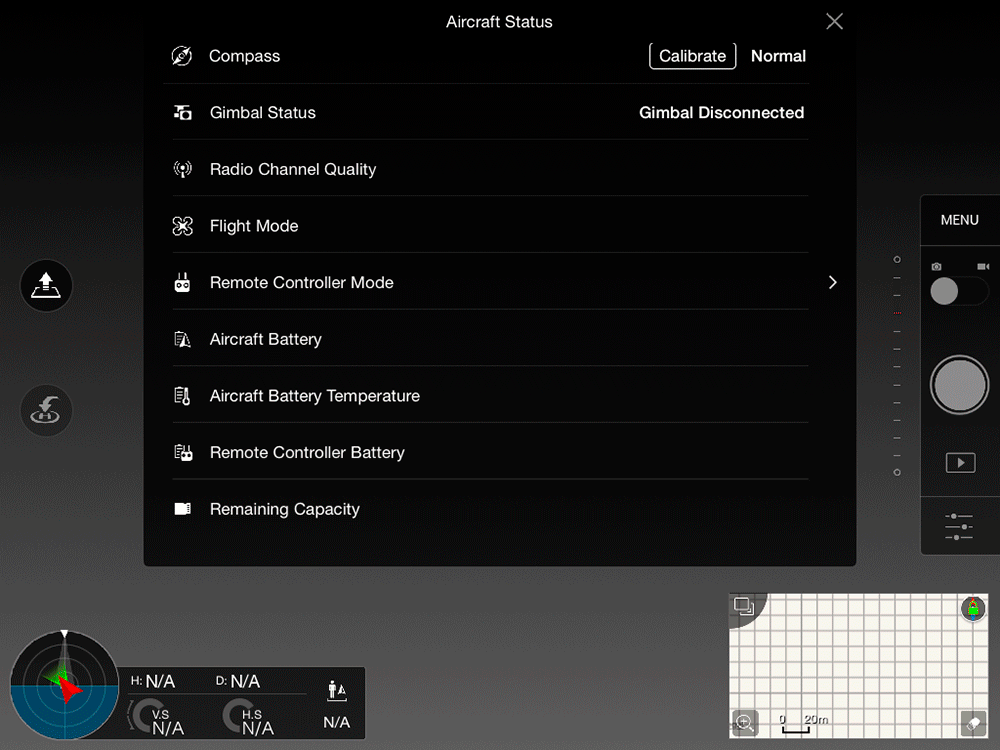
Universal application DJI GO - varies depending on the connected device.
Pleasant bonuses were received by the developers of compatible hardware / software - all sorts of new libraries, the new SDK, the ability to develop applications and hardware improvements for Phantom 4 ... In general, these are changes that can only be felt with time.
The update of Phantom 3 to Phantom 4 looks like a transition from any “evolutionary” iPhone to a “revolutionary” one. Here you have higher clarity, more speed, and a stylish new design, and new non-boring wallpapers ... in the sense, new useful features. Phantom 4, if not perfect, is good at almost everything, and is definitely worth every ruble spent on it.
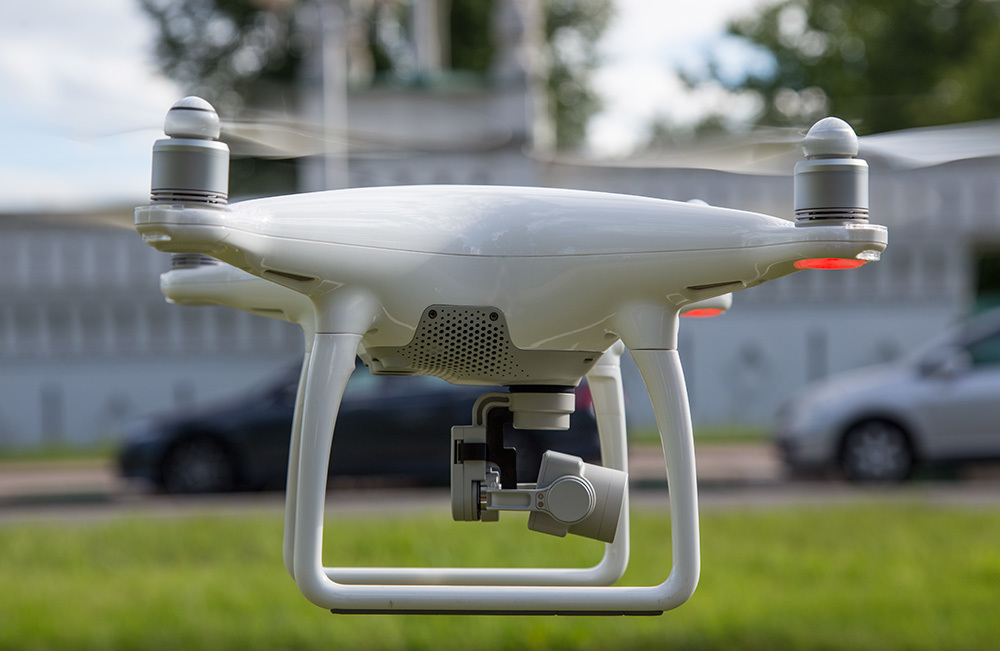
Oh yeah, about the rubles. The company finally decided to save customers from the problem of choosing the right model, so instead of assorted from different modifications, it presented a single one - just the Phantom 4. And you can buy this miracle of equipment, including on the shelves of M.Video. However, as a better "new iPhone", the new DJI is worth a lot - at the time of this writing, this is 124 thousand rubles . But at least you can be sure that you will not make a bad choice.
Have questions? Ready to answer them in the comments. Well and it, successful flights to you, keep there!

Phantom 4. Without any there Advanced, Pro and other consoles. What has changed, what has remained the same, how critical the changes are and how much will have to pay for all this magnificence - read here today.
Everything new is well forgotten old
One step is revolutionary, the second is evolutionary. So does Intel, so does Apple, so does DJI. This strategy even has a completely official name, " Tick-Tac ". Continuity in design and common features seem to be the same, if you don’t look at quadcopters every day, to say what has changed ... is difficult. Inside, everything is completely different. Literally every aspect of the drone has been redesigned. It is time to open the box and find out what's new there.
')



The device comes in a case with a handle, which can be used to transport the device - inside it contains all the parts (the drone itself, the remote, the blades, the tablet, charging and other trifles), and there is also a locking mechanism.
New camera and suspension
Shooting from the air - perhaps the key function of this class of devices. In the end, you do not just fly it so take it? Here it is. And the quality of the shooting in this case is influenced by two things: the camera module itself (matrix, optics) and how it is stabilized. And here and there, the new Phantom 4 has arguments.

In previous models, the camera attachment mechanism was visible: the rubberized vibration protection attached the stabilizer subframe to the frame with motors, the stabilizer itself was quite large and heavy. The four in this plan looks much simpler. The gyrostabilizer and vibroprotection are integrated into the design of the drone: the motors are more precise, the unsprung masses are lower, and the stabilization system now no longer uses only its own separate set of sensors, eliminating the effects of the movements, but receives data from the drone itself, and can calculate and compensate the movement before how it will begin.



The camera module has also been updated: perhaps, today it is one of the best “flying” cameras in the user segment. The matrix size is 1 / 2.3 "(like the standard" soap cases ", but still much larger than that of smartphones). Optics with a fixed focal length and viewing angle of 94 degrees are designed specifically for this matrix and taking into account the use of" in the sky ". The relative aperture of the aperture is f / 2.8, the focus is fixed at infinity. The zone of sharpness is approximately from 50-70 centimeters from the lens.

The main "limiter" with this camera module is the processor that will process the video stream. Its bandwidth is not bad - about 60 megabits per second, but this is far from a record.
At 4k2k and 2.7k (2716x1524) resolutions, the maximum available frame rate is 30. (2.7k is compressed from 4k2k, its main purpose is to save space, therefore the frame rate is the same as for higher resolution). A FullHD frame carries four times less information, so a four times higher frame rate is available for the FullHD format — up to 120FPS. Use it to increase the smoothness of the picture or slow down time - here, as you please.
Surprisingly, 720p is limited to 60FPS, apparently, it is also obtained by compressing FullHD, and the signal processor resources simply are not enough for 120FPS and video stream compression at the same time.
The developers have taken care that you can not only shoot, but also edit the video. For this camera added support for professional formats D-Log and Cine-D. Watching them “as is” is not much fun, but while processing and color correction in such a video there is much more useful information, you can achieve expressive shots in the shadows, and stunning bright sunsets, without changing the settings or interrupting the shooting.
This is what D-Log is capable of.
Of course, all 12 megapixels of the camera module are available in photographing mode. As a result, you can choose both classic .jpeg and / or Adobe RAW format (DNG).
From the box, the drone is able to shoot time lapse, carry out the usual serial shooting (up to 7 frames), as well as remove blanks for HDR with an exprovilka - from 3 to 5 frames in 0.7 EV steps.
Sample photos (with a small post-processing of the RAW file; clickable):






Case and new sensors
The camera is a camera, but it still needs to be delivered to heaven. In the most primitive version, the quadcopter frame is assembled from sticks and ... electrical tape. And nothing flies. But Phantom 4 is quite far from the word "primitive." His frame is a small work of art. Lightweight Durable in torsion. Minimally affecting the flow of exhaust air. Yes, and streamlined.


With a slight movement of the hand ... the blades are fixed on the little motors, and the Phantom 4 will only have to turn on - from the state “in the box” to “ready to fly” with proper skill it takes no more than a minute.
What does this give? The drone flies faster, higher, further (especially if you consider that the main problem for "further" are batteries and communication - here every milliamp saved by the resultant sound aerodynamics is a plus). Its less shakes the wind. The attachment point of the gimbal and the camera became closer to the center of mass, which means that the drone itself is easier to balance (and less energy is spent on it), and this also means that the camera suspension needs to spend less energy and time to deflect and correct rolls.

In general, there are improvements in aerodynamics, and there are continuous advantages from them. All of them in one way or another reduce energy consumption, simplify management and make video shooting more stable.
But it was not enough for engineers just to achieve amazing results with just one body. They added to this splendor 2 additional cameras and 2 ultrasonic sonars used to stabilize the flight and recognize obstacles.
New flight modes and intelligent control system
The system of sensors and cameras was implemented for a reason. DJI software developers literally performed a miracle: the drone received the Tap to Fly intelligent flight system. It works very simple. You choose the altitude, on the touch screen of your device you specify where to fly, and Phantom 4 obediently performs. Going round obstacles and trying to behave decently at all.
Sensors are also active in manual flight mode - if you fly stubbornly "into the wall", the Phantom 4 will feel it, 15 meters before it will begin to slow down, and after 5 meters it will begin to evade maneuver. If it works out, it will pick up the height / fly around the recognized obstacle, if not, it will simply stop.
Well, the third application for stereo cameras and sonars is ActiveTrack active tracking mode. If competitors fly behind objects, using only a picture from the camera, GPS, trackers and other pribludy, here for separation of moving objects from the background is enough stereo image. And to fly around obstacles, follow the target and keep it on the sight of the main camera is no longer so difficult.
The changes affected not only the drone, but also its console. True, in this case - no revolution. Improving the controller from the Phantom 3 (without appreciating it) is very difficult, but to “spoil” all the magic of a simple and convenient control is easy. Therefore, the changes are purely cosmetic and "internal", for the user, everything remained in its place, it works the same way as before. Finally, they signed a "nameless" button - now it is a "pause", which makes the drone instantly hang at the point where it is located.
Faster, higher, farther, stronger and more accurate
Simple arithmetic. The autonomy of the drone in average conditions increased by 25% compared with the previous generation. Motors have become more powerful: now the quadrocopter can deliver up to 70 km / h to calm and has a climb speed of up to 6 meters per second. At the same time, the battery increased by only ~ 20% (C ~ 4500 to 5500 mAh). That is, the direct difference - 5% - only due to aerodynamics, which allowed radically reduce energy consumption and spend less, doing more. Cool? Cool!

The drone comes with an adapter that can be charged at the same time as the remote and the battery. At the same time, the battery is quick-detachable and has a symmetrical charging connector.

A full charge of one battery lasts for about 25 minutes, and, unfortunately, you will always miss "well, just one more minute." At the same time, you hardly want to wait until full charge. Here, the only way out is to buy 1-2 spare batteries, however, each costs the same as an average smartphone.
The integrated camera suspension not only improved flight performance, but also became more accurate. It is easier, able to communicate with quadrocopter built-in sensors, the accuracy of servos is up to 0.3 degrees on each of the axes. Such a smooth and high-quality stabilization (with such compact dimensions) is extremely difficult to achieve, but DJI managed.
The accuracy of the positioning system (especially where it is especially important - that is, at a small height) also increased. The horizontal coordinates are kept within 30 centimeters, the vertical ones are within 10. Over 15 meters the error grows (up to 50/50, respectively), but there such a scatter does not cause inconvenience. This is achieved by the simultaneous operation of the sensor system and the navigation unit, which receives data directly from two satellite systems - GPS and GLONASS.
Inertial navigation blocks and digital compasses are duplicated - the difference in values allows you to eliminate the error / measurement error, and in the case of a malfunction of one of the modules - get home without any special adventures.
Software update
DJI, nevertheless, not for nothing called Apple in the field of quadcopters. In the best understanding of this comparison, a good iron, a well-chosen balance of characteristics, simplicity in mastering basic capabilities, deeply buried chips for those in the subject, and know how to squeeze the maximum out of the device ... And, of course, the synergy of software and hardware.
Together with Phantom 4, the DJI GO proprietary software was also updated. Improved training mode (he - “newcomer mode”, which appeared along with Phantom 3). A set of reasonable restrictions and the fully recognized obstacle recognition system will help to take the first steps in an aerial survey and not break the propellers.


Universal application DJI GO - varies depending on the connected device.
Pleasant bonuses were received by the developers of compatible hardware / software - all sorts of new libraries, the new SDK, the ability to develop applications and hardware improvements for Phantom 4 ... In general, these are changes that can only be felt with time.
Eventually
The update of Phantom 3 to Phantom 4 looks like a transition from any “evolutionary” iPhone to a “revolutionary” one. Here you have higher clarity, more speed, and a stylish new design, and new non-boring wallpapers ... in the sense, new useful features. Phantom 4, if not perfect, is good at almost everything, and is definitely worth every ruble spent on it.

Specifications
Maximum flight time
28 minutes
Maximum climb rate
6 m / s
Maximum speed of descent
4 m / s
Maximum flight speed
20 m / s (up to 70-80 km / h)
Operating temperature range
from 0 ° to 40 °
Satellite positioning
GPS, Glonass
Maximum flight altitude
120m, without limitation - up to 6000m in hardware, depends on the range of the remote control.
Vertical point holding error
with Vision Positioning - 0.1m, without - 0.5m
Horizontal error of point retention
with Vision Positioning - 0.3m, without - 1.5m
Weight
1380 grams
Lens
Angle of view (FOV) - 94 °, 35 mm, f / 2.8, focus - ∞
Matrix resolution
12 megapixels
Matrix size
1 / 2.3 "
ISO
Video: 100 - 3200, Photo: 100 - 1600
Maximum resolution
4000 × 3000 pixels
Exposure range
8 - 1/8000 sec.
Photo formats
JPEG, DNG (Adobe RAW)
Video formats
mp4, MOV (MPEG-4 AVC, H.264)
SD card support
Micro SD up to 64 gigabytes
Modes of shooting video
UHD: 4096 × 2160 (4K) - 24, 25p
3840 × 2160 (4K) - 24, 25, 30p
2704 × 1520 (2.7K) - 24, 25, 30p
FHD: 1920 × 1080 - 24, 25, 30, 48, 50, 60, 120p
HD: 1280 × 720 - 24, 25, 30, 48, 50, 60p
Frequency range
2.400 GHz to 2.483 GHz
Maximum signal transmission distance
FCC: 5km, CE: 3,5km
Transmitter power
FCC: 23 dBm; CE: 17 dBm
Battery
Lithium-polymer, 6000 mAh
Detection range
from 0.7 to 15 meters
Capacity
Lithium polymer, 5350 mA * h
Voltage
15.2 volts
Weight
462 grams
Voltage
17.4 volts
Power
100 watts
Quadcopter
Maximum flight time
28 minutes
Maximum climb rate
6 m / s
Maximum speed of descent
4 m / s
Maximum flight speed
20 m / s (up to 70-80 km / h)
Operating temperature range
from 0 ° to 40 °
Satellite positioning
GPS, Glonass
Maximum flight altitude
120m, without limitation - up to 6000m in hardware, depends on the range of the remote control.
Vertical point holding error
with Vision Positioning - 0.1m, without - 0.5m
Horizontal error of point retention
with Vision Positioning - 0.3m, without - 1.5m
Weight
1380 grams
Camera
Lens
Angle of view (FOV) - 94 °, 35 mm, f / 2.8, focus - ∞
Matrix resolution
12 megapixels
Matrix size
1 / 2.3 "
ISO
Video: 100 - 3200, Photo: 100 - 1600
Maximum resolution
4000 × 3000 pixels
Exposure range
8 - 1/8000 sec.
Photo formats
JPEG, DNG (Adobe RAW)
Video formats
mp4, MOV (MPEG-4 AVC, H.264)
SD card support
Micro SD up to 64 gigabytes
Modes of shooting video
UHD: 4096 × 2160 (4K) - 24, 25p
3840 × 2160 (4K) - 24, 25, 30p
2704 × 1520 (2.7K) - 24, 25, 30p
FHD: 1920 × 1080 - 24, 25, 30, 48, 50, 60, 120p
HD: 1280 × 720 - 24, 25, 30, 48, 50, 60p
Remote Control
Frequency range
2.400 GHz to 2.483 GHz
Maximum signal transmission distance
FCC: 5km, CE: 3,5km
Transmitter power
FCC: 23 dBm; CE: 17 dBm
Battery
Lithium-polymer, 6000 mAh
Obstacle detection module
Detection range
from 0.7 to 15 meters
Battery
Capacity
Lithium polymer, 5350 mA * h
Voltage
15.2 volts
Weight
462 grams
Charger
Voltage
17.4 volts
Power
100 watts
Oh yeah, about the rubles. The company finally decided to save customers from the problem of choosing the right model, so instead of assorted from different modifications, it presented a single one - just the Phantom 4. And you can buy this miracle of equipment, including on the shelves of M.Video. However, as a better "new iPhone", the new DJI is worth a lot - at the time of this writing, this is 124 thousand rubles . But at least you can be sure that you will not make a bad choice.
Have questions? Ready to answer them in the comments. Well and it, successful flights to you, keep there!

Source: https://habr.com/ru/post/369451/
All Articles